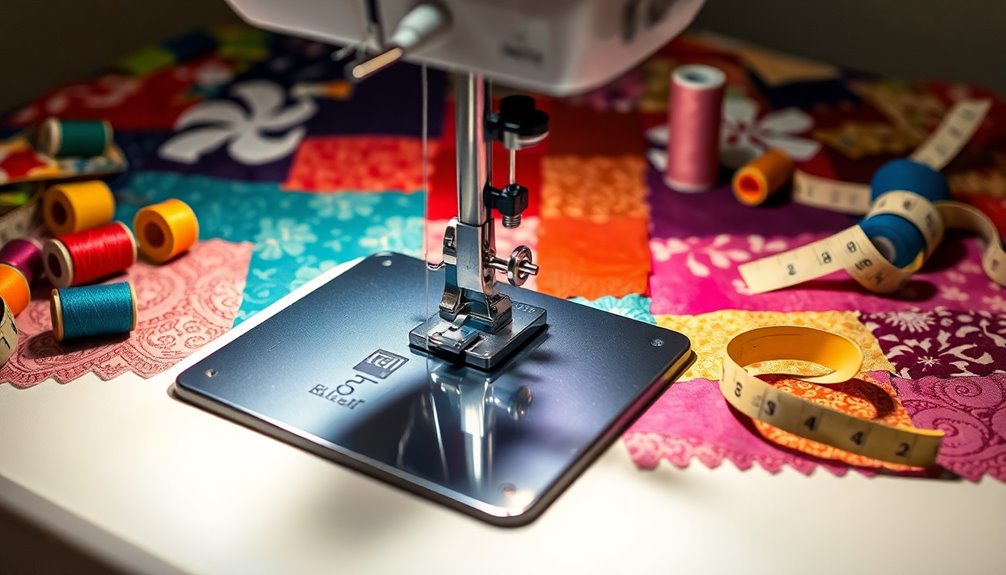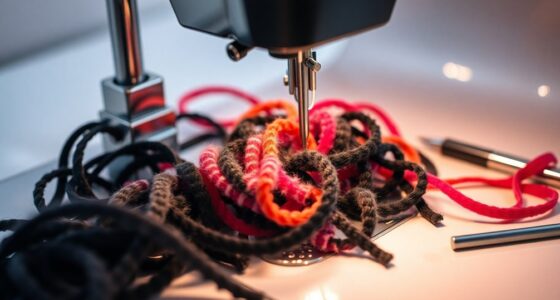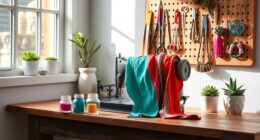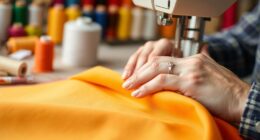Yes, you can sew without a presser foot, but it's tricky and can lead to inconsistent results. Without it, fabric control becomes difficult, especially for detailed projects. You might manage straight seams, but accuracy takes practice. There are risks like uneven stitching or even needle breakage. Using a darning foot can enhance your experience and reduce potential injuries. If you want to learn more about the challenges and tips for sewing without a presser foot, keep exploring!
Key Takeaways
- Sewing without a presser foot is possible, but results may be inconsistent and challenging to control.
- Accuracy in straight seams requires significant practice without the stability of a presser foot.
- Free motion quilting can be an alternative, but it demands careful fabric handling and attention.
- Risks include poor stitch quality, needle breakage, and increased chance of sewing injuries.
- A darning foot is recommended for free motion quilting to enhance stitch quality and safety.
What Is A Presser Foot?

A presser foot is an essential accessory for your sewing machine that helps keep fabric flat and in place while you sew. It connects to the ankle of the machine, holding various fabrics—like cotton, wool, and denim—securely as you work.
This guarantees neat, consistent stitching, which is especially important for projects like quilting. Common types of presser feet include the straight foot, zipper foot, zigzag foot, and satin foot, each tailored for specific tasks.
Most sewing machines, whether new or used, come with a standard or zigzag presser foot included. While you can technically sew without one, doing so may result in poor stitch quality and make controlling your fabric a real challenge.
Do I Need A Presser Foot To Use My Sewing Machine?

Can you sew effectively without a presser foot? While it's technically possible, you'll find that a presser foot is essential for achieving neat and precise results.
Without it, controlling your fabric can become tricky, especially with intricate projects. You might manage to sew straight seams, but it demands considerable practice to maintain accuracy.
Free motion quilting is another option, allowing you to stitch without a presser foot, but it requires careful handling to avoid accidents and to keep your fabric steady.
The effectiveness of sewing without a presser foot really depends on your specific sewing machine and its capabilities.
For the best results, especially on valuable projects, using a presser foot is the way to go.
How To Sew Without A Presser Foot

Sewing without a presser foot can be a rewarding challenge, especially if you're looking to explore techniques like free motion sewing.
To get started, focus on slow, careful stitches to gain confidence and control over the fabric. You can achieve straight seams without a presser foot, but it takes practice to master this skill.
Adjusting the top thread tension is essential to prevent thread breakage and guarantee smooth stitching. Consider using a hoop to manage your fabric and protect your hands while sewing.
Always keep an eye on your fingers to avoid accidents. With patience and practice, you'll find that free motion sewing can open up a world of creative possibilities.
Risks of Free Motion Quilting Without a Presser Foot

While free motion quilting without a presser foot might seem like an adventurous way to enhance your creativity, it comes with significant risks that shouldn't be overlooked.
Without the presser foot, you increase your chances of sewing fingers, as there's no protection while maneuvering fabric through your sewing machine. This absence can lead to poor stitch quality, leaving your projects looking uneven and messy.
You're also more likely to bend or break needles due to uncontrolled fabric movement and tension. Many quilters have shared experiences of accidents or injuries during free motion quilting without a presser foot, emphasizing the importance of safety.
Ultimately, using the right equipment can help guarantee a safer and more enjoyable quilting experience.
Importance of Using a Darning Foot

The darning foot is an essential tool for free motion quilting, markedly enhancing your sewing experience. It allows your fabric to move freely while maintaining consistent stitch quality. When you're quilting with no presser, the darning foot provides the necessary pressure to prevent slipping, ensuring even stitches. Plus, it keeps your fingers safe from the needle, reducing the risk of injury. Additionally, using a darning foot aligns with the principles of hands-on learning in crafting, promoting a deeper connection with your sewing projects.
| Benefits of Darning Foot | Impact on Quilting |
|---|---|
| Maintains even stitch quality | Enhances design creativity |
| Prevents fabric slipping | Allows intricate patterns |
| Compatible with many machines | Versatile for various techniques |
Using a darning foot can greatly improve your quilting experience, making your projects not only safer but also more beautiful.
Considerations Before Quilting Without a Foot

Before you decide to quilt without a presser foot, it's important to weigh several factors that can affect your sewing experience.
First, check if your sewing machine has a compatible free motion quilting foot. Using the right foot can greatly enhance stitch quality and control.
If a suitable foot isn't available, be cautious; quilting without a foot means there's no guard to protect your fingers from the needle, increasing the risk of injury.
Consider using a hoop to manage the fabric better and protect your hands, especially if you're a beginner.
Finally, adjusting the machine's top thread tension may be necessary when you quilt without a foot to prevent thread breakage and guarantee a smoother sewing experience.
Setup for Free Motion Quilting Without a Foot

To set up for free motion quilting without a presser foot, you'll first need to remove it from your machine.
Next, adjust the thread tension to a lower setting to keep the thread from snapping during your work.
These steps will help guarantee a smoother quilting experience as you get started.
Remove Presser Foot
Remove the presser foot from your sewing machine to release the full potential of free motion quilting. This move allows for greater fabric movement, essential for creating intricate designs.
Make sure to use a larger eye needle, which helps the thread pass smoothly and reduces the chance of breakage. As you immerse yourself in quilting without a presser foot, practice using the manual wheel of your machine. This will enhance your control and understanding of the fabric's movement.
Additionally, consider using a hoop to manage the fabric better and protect your hands from the needle while you master free motion techniques. With these adjustments, you'll be ready to quilt creatively and confidently.
Adjust Thread Tension
Adjusting the thread tension is essential for successful free motion quilting without a presser foot. Since you won't have the usual pressure from a presser foot, you might need to lower the top thread tension to allow the fabric to move freely.
Testing various tension settings on scrap fabric before diving into your project is a smart move, as different fabrics react differently. If you're working with a thicker thread, slightly increasing the tension can help prevent breakage while ensuring consistent stitch quality.
Remember to regularly check and adjust the tension as you sew, since the fabric’s movement can affect how the thread interacts with the needle and bobbin, leading to the best results. Additionally, it’s important to ensure that your threads are compatible with the type of fabric you are using, as this can significantly impact your sewing experience. Over time, neglecting tension adjustments can compromise the hand sewing needles performance over time, leading to uneven stitches or even thread breakage. Always take a moment to assess your setup before starting a new project to guarantee the highest quality results.
Challenges and Considerations When Quilting Without a Foot

While quilting without a presser foot can offer a unique sense of freedom, it also presents significant challenges that you'll need to navigate.
Without that foot, you might struggle with unpredictable fabric movement, making it tough to maintain consistent tension and stitch quality. High tension settings can lead to thread breakage, especially during intricate patterns, so using good quality thread is essential.
You'll also need to exercise caution, as the absence of a presser foot increases the risk of sewing your fingers. To help manage fabric stability, consider using a hoop, particularly if you're a beginner.
Adjusting your machine's top thread tension is important too, as the lack of a walking foot alters how the fabric interacts with the needle. Additionally, maintaining consistent tension is crucial to avoid complications similar to those faced when using essential oils for toothache relief.
Community Insights and Experiences

Many quilters find that sharing their experiences can greatly enhance your understanding of sewing without a presser foot.
In community discussions, many emphasize the importance of the presser foot for maintaining control and achieving consistent stitch quality. They often caution against free motion quilting without it, pointing out the risks of needle accidents and poor stitch outcomes.
Experienced quilters recommend starting with a darning foot for free motion quilting to guarantee safety and better results.
On quilting forums, you'll discover tips and alternative techniques for managing fabric movement without a presser foot.
While it's possible to sew without one, seasoned quilters agree that it requires significant practice and careful attention to technique for best results.
Frequently Asked Questions
Can I Use My Sewing Machine Without the Presser Foot?
You might be wondering if you can use your sewing machine without the presser foot.
While it's technically possible, it's not a good idea. Without the presser foot, your fabric can slip or bunch up, leading to uneven stitches.
You may also find it harder to control the fabric's movement.
It's best to practice with a presser foot first to guarantee neat results and avoid any potential accidents.
Safety and quality matter!
Is a Presser Foot Necessary?
Did you know that using the right presser foot can improve your stitch quality by up to 50%?
While technically you can sew without a presser foot, it's definitely not ideal. A presser foot keeps your fabric flat and secure, ensuring even stitches.
It's especially important for complex designs or delicate materials. For the best results and a professional finish, you'll want to use the appropriate presser foot for your project.
Can You Sew on a Sewing Machine Without a Foot Pedal?
Yes, you can sew on a sewing machine without a foot pedal if your machine has a start/stop button. This feature lets you control stitching easily.
Some machines even have a speed control slider, making it perfect for beginners. However, if your machine doesn't support this, using the handwheel can be tricky for consistent stitching.
Always check your machine's manual to see what options are available for your specific model.
Can You Sew Standing?
Imagine a craftsman shaping clay while standing, each movement grounded yet dynamic.
You can absolutely sew while standing, and it might even boost your creativity! Adjust your machine's height or find a suitable table to maintain comfort.
Just remember to keep your balance for smooth fabric control. Standing encourages a more active posture, which can reduce strain and enhance focus.
A supportive mat underneath can further ease fatigue during those longer sessions.
Conclusion
Sewing without a presser foot can feel like steering a ship without a compass—exciting yet risky. While it's possible to create beautiful pieces, remember that the right tools make the journey smoother. Embrace the challenge, but stay mindful of the potential pitfalls. Whether you choose to forgo the presser foot or not, each stitch tells a story. So, trust your instincts and let your creativity lead the way, crafting your unique masterpiece.









